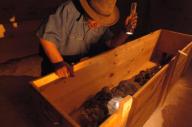|
|
||
| Diagnostic imaging | ||
CT scans and DNA tests help unveil mystery of long-lost female pharaoh13 July 2007 Cairo, Egypt. Computed tomography (CT) scanning and DNA analysis has helped solve the mystery of what happened to one of ancient Egypt's most powerful and successful rulers. Secretary General of Egypt's Supreme Council of Antiquities Dr. Zahi Hawass unveiled in an international press conference at Cairo's Egyptian Museum a 3,500-year-old mummy now positively identified as Hatshepsut, one of history's few female pharaohs. More powerful than Cleopatra or Nefertiti, Hatshepsut stole the throne from her young stepson, dressed herself as a man and in an unprecedented move declared herself pharaoh. Though her power stretched across Egypt and her reign was prosperous, Hatshepsut's legacy was systematically erased from Egyptian history. Historical records were destroyed, monuments torn down and her corpse removed from her tomb-and her death is shrouded in mystery. Dr Hawass's odyssey of archaeological and scientific adventure has been documented in Discovery Channel's Secrets of Egypt's Lost Queen, which premieres on July 15, 2007 (UK 17 July and some countries later). The investigative journey of Dr Hawass and his team led them through the massive crypts beneath Egypt and into the depths of the Egyptian Museum. Using knowledge of royal Egyptian mummification and clues from two known tombs linked to Hatshepsut, the team narrowed their search for Hatshepsut to just four mummies from thousands of unidentified corpses.
CT scanning allowed the scientists to link distinct physical traits of the four mummies to those of Hatshepsut's known relatives. The search further narrowed to two possibilities — both from the tomb of Hatshepsut's wet nurse — but the final clue lay within a canopic box inscribed with the female pharaoh's name. A scan of the box found a tooth that, when measured, perfectly matched a missing upper molar in one of the two mummies. Equipment from Siemens Medical Solutions allowed scientists to conduct detailed CT scanning of each of the mummies. The archaeologists were able to go beneath the wrappings and fragile bodies of some of Egypt's greatest pharaohs without damaging them. "Secrets of Egypt's Lost Queen brings archaeology alive for viewers," said Jane Root, president and general manager, Discovery Channel and The Science Channel. "We are proud to be part of this significant find, and commend Dr Hawass and his team for their hard work and dedication." Applied Biosystems, the leading global provider of DNA analysis technologies, and Discovery Quest, Discovery Channel's initiative to support the scientific community's work, enabled the construction of and equipment for the first-ever ancient DNA testing facility located in the Cairo Museum in Egypt. The DNA testing facility will not only be used to extract and compare nuclear and mitochondrial DNA of the Hatshepsut mummy and mummies from her family, but will be used by scientists to examine future finds in Egypt and attempt to clarify familial relationships among the royal families. The Discovery Quest fund reaffirms Discovery Channel's commitment to support groundbreaking research and inventions that change our world. "Through Discovery Quest, Discovery Channel is at the forefront of the most significant scientific discoveries of our time," said Steve Burns, executive vice president, Discovery Quest, and chief science editor. "The Discovery Quest program strives not only to make these discoveries accessible for viewers, but also to make what we hope is a positive, lasting impression on scientific research by providing valuable resources for equipment and research expeditions." See also: CT scans reveal 3000 year old mummy of Egyptian princess (16 Feb 2009) Results of Tutankhamen scan revealed (March 2005) CT scans unwrap secrets of British Museum's Egyptian mummies (April 2005)
|
